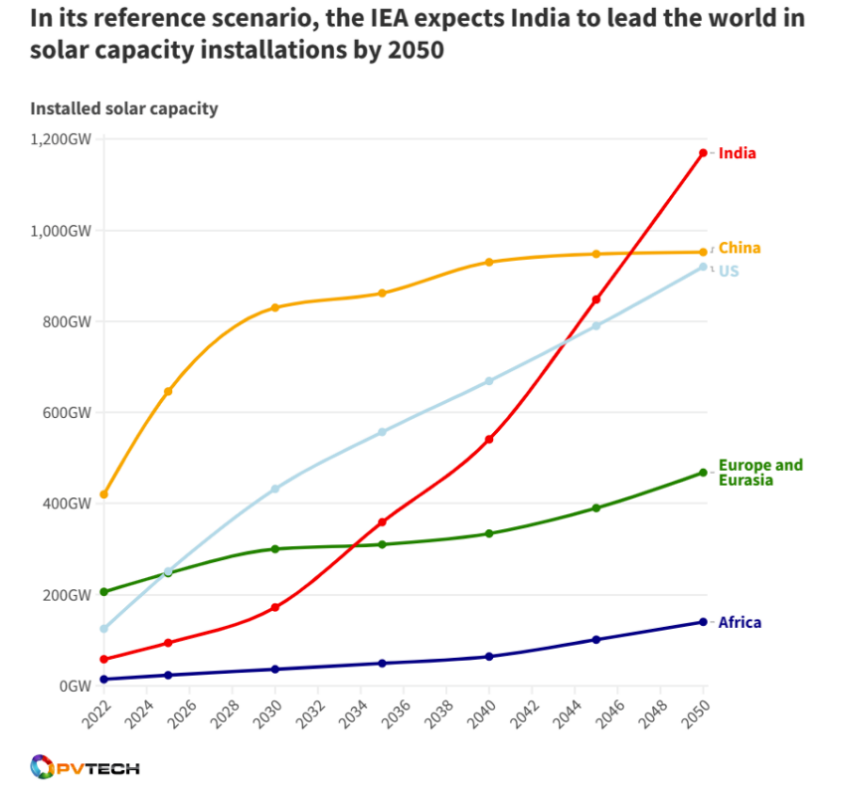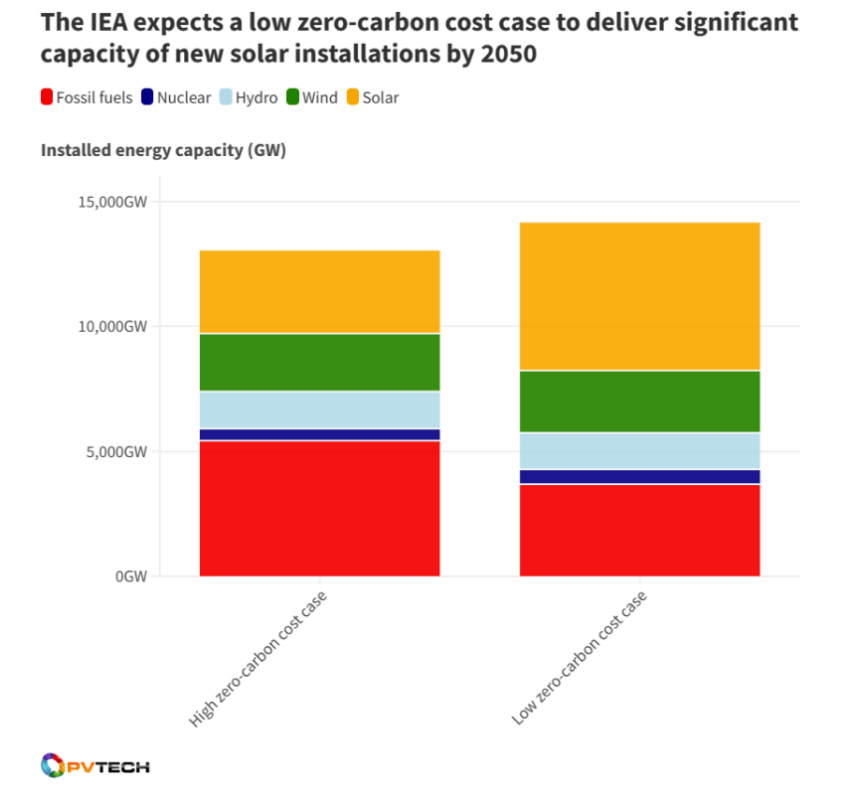
- English
- Español
- Português
- русский
- Français
- 日本語
- Deutsch
- tiếng Việt
- Italiano
- Nederlands
- ภาษาไทย
- Polski
- 한국어
- Svenska
- magyar
- Malay
- বাংলা ভাষার
- Dansk
- Suomi
- हिन्दी
- Pilipino
- Türkçe
- Gaeilge
- العربية
- Indonesia
- Norsk
- تمل
- český
- ελληνικά
- український
- Javanese
- فارسی
- தமிழ்
- తెలుగు
- नेपाली
- Burmese
- български
- ລາວ
- Latine
- Қазақша
- Euskal
- Azərbaycan
- Slovenský jazyk
- Македонски
- Lietuvos
- Eesti Keel
- Română
- Slovenski
- मराठी
- Srpski језик
India's solar energy installation will rank first in the world!
The US Energy Information Administration (EIA) is a branch of the US government responsible for global energy industry research. The latest International Energy Outlook report released by the agency predicts that India's solar installed capacity will dominate the world by 2050.
The EIA released the report earlier this week, which is the latest in a series of annual publications predicting the global energy structure in 2050. The report simulates some scenarios related to the application of global zero carbon technology and the costs associated with this transition.
The EIA pointed out that its expectations did not take into account important legislation or regulations that may have been passed, such as the Inflation Reduction Act, which had a profound impact on the US energy industry. However, the report remains a very useful tool for reflecting on the changes that the solar industry can expect in the coming years.

India will lead the solar energy industry
The most striking conclusion in the report may be that the EIA predicts that by 2050, the global solar industry will no longer be dominated by the current industry giants China and the United States, but by India. These numbers come from the EIA's "reference" scenario, which is the prediction made by the EIA for its "Annual Energy Outlook" series of documents. The EIA acknowledges that this is not the "most likely prediction for the future, but a baseline for estimating the impact of policy or technological changes

The most striking conclusion in the report may be that the EIA predicts that by 2050, the global solar industry will no longer be dominated by the current industry giants China and the United States, but by India. These numbers come from the EIA's "reference" scenario, which is the prediction made by the EIA for its "Annual Energy Outlook" series of documents. The EIA acknowledges that this is not the "most likely prediction for the future, but a baseline for estimating the impact of policy or technological changes
Solar energy will also dominate India's domestic energy structure. According to IEA data, India's solar installed capacity will grow at an average annual rate of 11.3% from 2022 to 2050, surpassing all other countries. In contrast, India's liquid fuel production has decreased by 11.4% annually. This indicates that India will not only invest heavily in solar power capacity in the coming decades, but may also attract investment from its historically high yield oil and gas sectors.
Among all the countries surveyed, solar power generation is expected to grow at an astonishing rate. In Africa, the average annual growth rate of solar installed capacity is 8.5%, which ranks with the highest growth rate of geothermal power generation in Africa. It is expected that by 2050, the total installed capacity of the African solar industry will reach 140GW, while the installed capacity of the geothermal industry is only 8GW.
Similarly, the average annual growth rates of the solar energy industries in Europe, Eurasia, and the United States each rank second, after geothermal power generation and battery energy storage. This indicates that although the focus of investment in new energy infrastructure varies, solar energy is an attractive investment choice for many regions.
According to EIA predictions, by 2050, India's solar installed capacity will account for more than one eighth of the global solar installed capacity. This transformation also indicates that the concentration of global solar installed capacity will be lower than the current level. According to the EIA, in 2022, China accounted for 4.2GW of the global 1.4TW solar installed capacity, alone responsible for nearly one-third of the global solar installed capacity.
Solar energy is thriving under the scenario of low and zero carbon costs
The report also predicts two different cost scenarios for energy transformation before 2050. One scenario is the higher decarbonization cost of the world's energy structure, resulting in lower possibilities for innovation and investment in renewable energy; The other scenario is the opposite.
This is particularly evident in the field of solar energy, as developers and manufacturers continue to invest in new technologies and manufacturing processes to improve the conversion efficiency of solar modules. Therefore, the sustained growth of the global solar energy industry requires significant financial investment, ensuring that new solar energy research and development is carried out in a cost-effective manner is a prerequisite for the expansion of the industry.

The EIA report states that under low zero carbon costs, the installed capacity of the global solar industry will reach 5.9TW, while under high zero carbon costs, it is only 3.3TW. The changes in the United States are most significant, with an expected installed capacity of 550GW in the high cost scenario and 1.2TW in the low cost scenario. This change is equivalent to more than doubling the installed capacity of solar energy in the United States, which accounts for about one-fifth of global installed capacity.
Other significant impacts will be reflected in Africa and India, with Africa's installed capacity increasing from 93GW to 235GW, and India's installed capacity increasing from 877GW to 1.4TW. At the same time, in both scenarios, China's contribution to the global solar energy industry will remain relatively unchanged. In the high cost scenario, China's installed capacity is 847GW, while in the low cost scenario, China's installed capacity is 1.5TW, accounting for about a quarter of the global total solar energy installed capacity.
For the entire energy transformation, perhaps the most encouraging thing is that the expected growth under the low-cost scenario will also lead to a reduction in fossil fuel installed capacity. In the high cost scenario, the installed capacity of the fossil fuel industry is expected to reach 5.4MW, while in the low cost scenario, this number will decrease by about one-third to 3.7MW. This indicates that, as expected in India, the expansion of the solar energy industry will shift the funding and attention of traditional power generation.
EIA Director Joe DeCarolis stated in a statement accompanying the report: Renewable energy has become an increasingly cost-effective source of electricity, with the fastest growth occurring in the context of rapid economic growth and increasing electricity demand. "DeCarolis also talked about the importance of investing in battery energy storage as part of this transition. Developing effective energy storage solutions is an indispensable part of the transition to clean energy, particularly in China and the United States.
DeCarolis continued, "In 2022, battery energy storage accounts for less than 1% of global electricity capacity." The EIA predicts that by 2050, battery energy storage capacity will increase to 4% -9% of global electricity capacity. “



